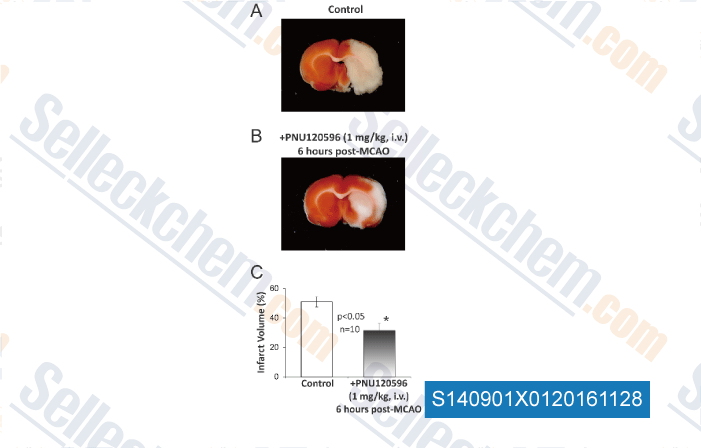|
Toll Free: (877) 796-6397 -- USA and Canada only -- |
Fax: +1-832-582-8590 Orders: +1-832-582-8158 |
Tech Support: +1-832-582-8158 Ext:3 Please provide your Order Number in the email. |
Technical Data
| Formula | C13H14ClN3O4 |
|||
| Molecular Weight | 311.72 | CAS No. | 501925-31-1 | |
| Solubility (25°C)* | In vitro | DMSO | 62 mg/mL (198.89 mM) | |
| Ethanol | 1 mg/mL (3.2 mM) | |||
| Water | Insoluble | |||
|
* <1 mg/ml means slightly soluble or insoluble. * Please note that Selleck tests the solubility of all compounds in-house, and the actual solubility may differ slightly from published values. This is normal and is due to slight batch-to-batch variations. * Room temperature shipping (Stability testing shows this product can be shipped without any cooling measures.) |
||||
Preparing Stock Solutions
Biological Activity
| Description | PNU-120596 (Nsc 216666) is a positive allosteric modulator of α7 nAChR with EC50 of 216 nM. | ||
|---|---|---|---|
| Targets |
|
||
| In vitro | PNU-120596 increases agonist (Ach)-evoked calcium flux mediated by an engineered variant of the human α7 nAChR. PNU-120596 increases agonists (choline and ACh)-evoked currents mediated by wild-type receptors and also demonstrates a pronounced prolongation of the evoked response in the continued presence of agonist in Xenopus oocytes. PNU-120596 increases the channel mean open time ofα7 nAChRs but has no effect on ion selectivity and relatively little, if any, effect on unitary conductance. When applied to acute hippocampal slices, PNU-120596 increases the frequency of ACh-evoked GABAergic postsynaptic currents measured in pyramidal neurons; this effect is suppressed by TTX, suggesting that PNU-120596 modulates the function of α7 nAChRs located on the somatodendritic membrane of hippocampal interneurons. [1] Besides the positive modulation to α7 nAChR, PNU-120596 induces a profound retardation of the kinetics of desensitization, raising the potential of Ca2+-induced toxicity through excessive stimulation of α7 nAChR. [2] PNU-120596 causes changes in cysteine accessibility at the inner beta sheet, transition zone and agonist binding site while binding to α7 nAChR. Binding sites for PNU-120596 are not in the agonist-binding sites and PNU-120596 enhances agonist-evoked gating of nicotinic receptors by eliciting conformational effects that are similar but nonidentical to the gating conformations promoted by Ach. [3] | ||
| In vivo | Systemic administration of PNU-120596 (1 mg/kg) to rats improves the auditory gating deficit caused by amphetamine, a model proposed to reflect a circuit level disturbance associated with schizophrenia. [1] When administered prior to Carrageenan, 30 mg/kg PNU-1230596 significantly blunts mechanical hyperalgesia and weight bearing deficits for up to 4 hours. PNU-120596 attenuates the carrageenan-induced increase in levels of TNF-α and IL-6 within the hindpaw oedema, diclofenac only attenuated IL-6 levels. Established mechanical hyperalgesia induced by Carrageenan or CFA is also partially reversed by PNU-120596. [4] |
Protocol (from reference)
| Kinase Assay:[1] |
|
|---|---|
| Cell Assay:[2] |
|
| Animal Study:[1] |
|
References
Customer Product Validation

-
, , PLoS One, 2013, 8(8): e73581.

-
Data from [Data independently produced by , , PLoS One, 2013, 8(8):e73581.]
Selleck's PNU-120596 has been cited by 9 publications
| Systemic Administration of α7-Nicotinic Acetylcholine Receptor Ligands Does Not Improve Renal Injury or Behavior in Mice With Advanced Systemic Lupus Erythematosus [ Front Med (Lausanne), 2021, 8:642960] | PubMed: 33928103 |
| Inhibitory effect of sinomenine on lung cancer cells via negative regulation of α7 nicotinic acetylcholine receptor [ J Leukoc Biol, 2020, 10.1002/JLB.6MA0720-344RRR] | PubMed: 32726882 |
| Alpha 7 nicotinic receptor agonist and positive allosteric modulators improved social and molecular deficits of MK-801 model of schizophrenia in rats. [ Pharmacol Biochem Behav, 2020, 10.1016/j.pbb.2020.172916] | PubMed: 32220620 |
| Investigating the Binding Interactions of NS6740, a Silent Agonist of the Nicotinic Receptor [ Mol Pharmacol, 2019, 10.1124/mol.119.116244] | PubMed: 31175182 |
| Boosting Endogenous Resistance of Brain to Ischemia. [Sun F, et al. Mol Neurobiol, 2017, 54(3):2045-2059] | PubMed: 26910820 |
| Boosting Endogenous Resistance of Brain to Ischemia [Sun F, et al. Mol Neurobiol, 2016, 10.1007/s12035-016-9796-3] | PubMed: 26910820 |
| An Unaltered Orthosteric Site and a Network of Long-Range Allosteric Interactions for PNU-120596 in α7 Nicotinic Acetylcholine Receptors [ Chem Biol, 2015, 22(8):1063-73] | PubMed: 26211363 |
| A positive allosteric modulator of α7 nAChRs augments neuroprotective effects of endogenous nicotinic agonists in cerebral ischaemia [ Br J Pharmacol, 2013, 169(8):1862-78] | PubMed: 23713819 |
| A Type-II Positive Allosteric Modulator of α7 nAChRs Reduces Brain Injury and Improves Neurological Function after Focal Cerebral Ischemia in Rats. [Sun F, et al. PLoS One, 2013, 8(8): e73581] | PubMed: 23951360 |
RETURN POLICY
Selleck Chemical’s Unconditional Return Policy ensures a smooth online shopping experience for our customers. If you are in any way unsatisfied with your purchase, you may return any item(s) within 7 days of receiving it. In the event of product quality issues, either protocol related or product related problems, you may return any item(s) within 365 days from the original purchase date. Please follow the instructions below when returning products.
SHIPPING AND STORAGE
Selleck products are transported at room temperature. If you receive the product at room temperature, please rest assured, the Selleck Quality Inspection Department has conducted experiments to verify that the normal temperature placement of one month will not affect the biological activity of powder products. After collecting, please store the product according to the requirements described in the datasheet. Most Selleck products are stable under the recommended conditions.
NOT FOR HUMAN, VETERINARY DIAGNOSTIC OR THERAPEUTIC USE.
